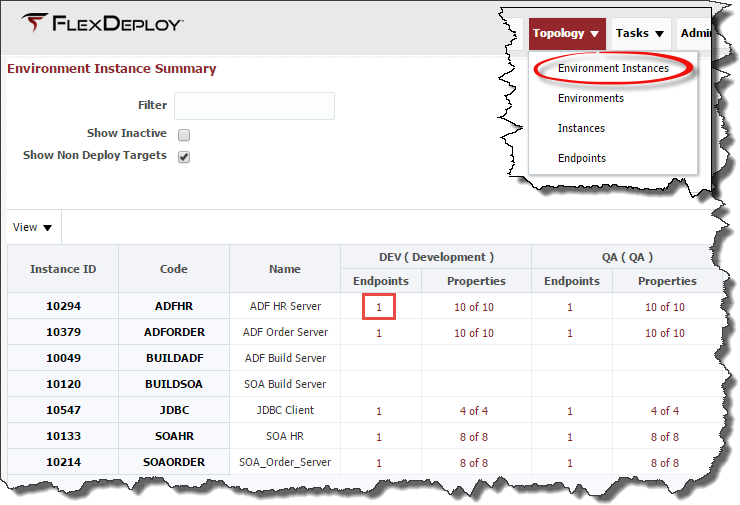An Environment Instance, as its name suggests, is simply an association between one environment and one instance. An Environment Instance is created by either associating an instance to an environment on the edit/create environment wizard, or associating an environment to an instance on the edit/create instance wizard. The association can then be used to assign endpoints and provide values for any properties mapped to those environment instances (through workflows or plugins).
...
For example, the table below depicts four environments identified as rows, and two instances which are identified as columns. Each environment instance combination defines which endpoint(s) host the instance for that environment, and the environment specific properties which are required to communicate to the underlying technology. Note that the SOA2 instance in the DEV and SIT environments do not have any endpoints or configuration properties defined because SOA2 is not associated with those environments.
Figure 5.30 The image below depicts the environment instances for SOA2. In this case, the FlexDeploy SOA Plugin's soaDeploy operation was associated to the SOA2 instance. The soaDeploy operation defines several environment instance scoped properties that must be defined for the operation to succeed.
...
| SOA1 | SOA2 |
|---|---|---|
DEV | Endpoint(s) | N/A |
SIT | Endpoint (s) | Endpoint (s ) |
UAT | Endpoint (s) | N/A |
PROD | Endpoint (s) | Endpoint (s) |
...
Notice that in the table below the wls_customer and wls_order instances (domains) share the same hosts/endpoint in the DEV and SIT environments, but only share some of the same hosts/endpoint in the UAT and PROD environments. Mapping the instances to the WLS domains allows the flexibility to match the endpoint and properties to your exact topology.
|
| wls_customer | wls_order |
|---|---|---|---|
DEV | Endpoints | Endpoints | |
SIT | Endpoints | Endpoints | |
UAT | Endpoints | Endpoints | |
PROD | Endpoints | Endpoints |
...
Viewing Environment Instances
To view the Environment Instances that have been established select Topology -> Environment Instances from the menu.
...
...
Associating Endpoints to Environment Instances
Each Environment Instance has an Endpoints column, which indicates the number of Endpoints that are associated to it. Click on the number in the Endpoints column to provide the ability to add or remove associations to the endpoint(s).
...
Click the Save button to save the changes, and then click the Back button to return to the previous screen.
...
Updating Environment Instance Properties
...
Anchor
...
The properties are linked to the environment instance because either one or more of the workflows or plugin operations associated to the instance have Environment Instance scoped properties defined. These Environment Instance scoped properties must have values defined for every Environment to which that instance is mapped. This provides, for example, the ability to define unique Weblogic Admin Server host and port for each environment instance.
See Properties chapter for more details.Anchor
